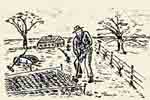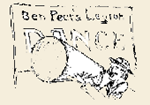|
My Wallet of Receipts
An Exploration into how the Barter System
worked in Upstate New York
during the Nineteenth Century
by
Gary Lehmann

There comes a time in the on-going life of every family when a household
must be cleared out to make room for new life. This past summer, I spent
many long days hauling out bags of old clothes and newspapers in twined-up
bundles. Grandma and her line were prodigious hoarders, but as frequently
happens in this sort of adventure, more than a few interesting objects
popped to the surface.
Chief amongst these treasures was a small leather wallet which was used
by an ancestor named David A. Sheldon to record business transactions
made between 1825 and 1842 in and around Richfield Springs, Cooperstown,
and Springfield Center, New York. Family records indicate that Sheldon
married a Bigelow daughter and thus became part of the family tree about
1825.
The wallet, which measures 3x5 inches, is made of fine leather folded
over several times to create a number of sewn pockets to enclose small
scraps of paper that record transactions for the purchase or sale of Indian
meal, corn, wheat, sheep, flour, stove pipe, shoe leather, apples, pork,
veal, potatoes, oats, flax seed, hay, cider, and rough stone. When a debit
or credit was satisfied, Sheldon put a big "X" over the annotation.
What becomes clear reading through these receipts is how very complex
a commercial transaction becomes before the time when the U.S. government
guaranteed the value of paper currency. Without reliable paper money,
the community largely had to transact business in other ways. Until reading
this wallet of receipts, it never dawned on me how complex that barter
system had to become to keep up. For example, grain goes bad relatively
quickly. If you can't eat it or feed it to your animals, you need to convert
it to flour or sell it right away. Fresh cider doesn't last but a few
weeks, but it can be converted to a future asset if you can get it to
your neighbors in time.
At the simplest level, goods are traded for goods, and a paper receipt
records the transaction. Sometimes, goods or services are paid for in
gold or silver coins or bullion. That is why even simple 19th century
farmers had what we call jeweler's scales in their homes. One of these
came to light from grandma's house. As an example of a "simple" transaction,
Sheldon has a receipt in his wallet that records the payment of ten dollars
from his father-in-law who he apparently successfully sued for this sum
in 1836. Bigelow paid in cash.
More often than not, a trade turned out uneven. One person offered goods
valued at more than the other had to give at that time. To resolve the
difference, a credit memo was recorded on the back of one receipt and
a debit memo on the back of the other. In the absence of reliable paper
money, which was not available until 1857, IOUs were exchanged to balance
out the transaction.
Sometimes a third hand records accepting that debit or credit as part
of a later trade. Thus, Sheldon paid a firm by the name of Stowell & Story
in Cooperstown the sum of $75.43 on James Cordell's behalf. In so doing,
Sheldon either discharged his debt to Cordell or created a new debt which
Cordell would have to discharge later on in some similar way. In effect,
the members of this small agricultural community are creating their own
paper currency in the form of what we might call commercial paper.
The total number of names that appear in this wallet of receipts does
not exceed thirty over a period of 16 years. We know from census records
that the entire community was much larger than that. So it must be that
the circle of trusted people was not as large as the population of the
entire community. There probably were people, even whole families, in
this community who had earned a position outside of this system of mutual
trust, but within the trusted members of the community, these little notes
made trades easier and quicker.
You stood to lose out on a lot of trading if you had to have your bushels
of wheat ready to trade at the exact same time and precisely the same
value as my bushels of corn. How much easier it was to hand over the goods
when they were fresh and ready and then even up the score when the other
person was in a position to reciprocate.
Thus, Delos [Delores?] Lothrip [Lathrop?] paid Robert Ormston the sum
of $1 in cash for a debt he held against Pamelia [Pamela?] Sheldon on
Dec 16th, 1825. Mrs. Sheldon received a receipt from Ormston indicating
that her debt to him was paid. The third party nature of the transaction
makes the whole economic system much more flexible. On June 17th, 1830
David Sheldon paid $30 to Joseph Stocking to settle the debt of a third
party.
In March of 1840, David Sheldon, shy of ready cash, paid his hired hand,
Th. S. Wilkins his wages for the past six months in a note which he could
use to buy goods and services anywhere in the community as long as Sheldon
was generally perceived to be a good credit risk. On May 8th, 1828, Sheldon
wrote out what amounts to a bearer bond or check to the order of an unnamed
party. "Sir please to pay the bearer three dollars and fifty cents on
my account." The bearer, perhaps a visitor to the community, now had paper
which he could use to buy things within the community.
Similarly Sheldon could go to the store and buy a bonnet and some red
ribbon for his wife and pay for it with some money, a couple of straw
hats and a pair of woolen socks, all goods which could be recycled from
the store shelves. As it happened, the transaction was uneven, and so
on the back of the receipt Sheldon indicated the extent of his further
indebtedness.
Sometimes, the signatures of witnesses appear at the bottom of a transaction
receipt, perhaps indicating that some mistrust existed between the parties
and they had to employ witnesses to avoid further controversy concerning
the payment.
Sometimes, no money is involved. On September 14th, 1827, Sheldon lent
the use of twenty "sheap" to Barney N. Windsor for two years after which
he had to return twenty "sheap" together with forty pounds of wool, rent.
All the rest of the wool Windsor might gather from tending the sheep for
two years would be his own. If I understand this system correctly then,
Sheldon might even sell a future interest in his sheep right now, based
on the paper indebtedness he held on them, even though they might not
be delivered until September 1829 at his "dwelling house in Springfield."
This paper currency makes a commodities market out of local farming.
At one point, David A. Sheldon receives a piece of paper in exchange
for the discharge of a will which calls for Sheldon to receive twenty-six
pounds, one shilling from the estate of David Little, deceased. It surprised
me at first to find receipts dated this late denominated in English currency,
but in a barter system what difference does it make? The form of establishing
value really doesn't matter as long as the exchange rate is steady. The
price of something is just a benchmark of value.
What David A. Sheldon's wallet of receipts shows me is that a community
can get along economically without very much hard currency if trust exists
between the members. In this period there were no bank regulations. Thus,
anyone could start a bank and in effect say to the public. "Look, I have
a building I have labeled as a bank. Bring me your gold and silver and
I will give you paper which says I have your money on deposit. Of course,
if someone robs the bank, your money is gone. I can't give you what I
no longer have."
All too often it was the banker himself who stole money from the vault
to make his own expenses. At that point, to be fair, he just redeemed
his bank notes at a percentage of their face value, so there would be
enough to go around. The public had no assurances that they would get
back anywhere near the money they put in. Clearly, barter, together with
the addition of commercial paper within a circle of trusted friends was
a much more reliable way to do business.
Of course, the system did fail from time to time. Sheldon had to take
his own father-in-law to court to get satisfaction, but that happens even
today when the value of our currency is guaranteed by the "good faith
and credit of the United States government." Some things never change.
© 2003, Gary Lehmann
| 


